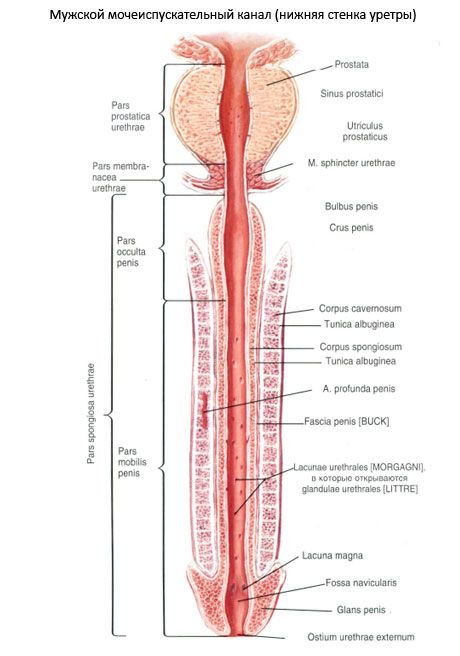Male urethra
Last reviewed: 23.04.2024

All iLive content is medically reviewed or fact checked to ensure as much factual accuracy as possible.
We have strict sourcing guidelines and only link to reputable media sites, academic research institutions and, whenever possible, medically peer reviewed studies. Note that the numbers in parentheses ([1], [2], etc.) are clickable links to these studies.
If you feel that any of our content is inaccurate, out-of-date, or otherwise questionable, please select it and press Ctrl + Enter.
Male urethra, or male urethra (urethra masculina), is an unpaired organ that has the shape of a tube 0.5-0.7 cm in diameter and 16-22 cm in length. It serves to excrete urine and discard the seed. It begins with the internal opening of the urethra (ostium urethrae internum) in the wall of the bladder and ends with the outer opening (ostium urethrae externum) located on the glans penis. Topographically, the male urethra is divided into three parts: prostate, membranous and spongy, and from the point of view of mobility - to a fixed and mobile one. The border between the latter is the place of attachment to the penis of the sinewy ligament of the penis.
The prostate (pars prostatica) of the urethra has a length of about 3 cm, passes in the descending direction through the prostate gland. The lumen of the male urethra in the middle section is enlarged. On the posterior wall of the prostatic part of the urethra is the elongated prominence - the crest of the urethralis. The most prominent part of this crest is called the seed hillock, or the seminal hillock (colliculus seminalis), on top of which there is a depression - the prostate (utriculus prostaticus), which is the rudiment of the terminal compartment of the parasezonephalic ducts. On the sides of the prostatic muzzle open the mouth of the ejaculatory ducts. On the circumference of the most seminal mound there are holes of the excretory ducts of the prostate gland.

The membranous part (pars membranacea) extends from the apex of the prostate gland to the bulb of the penis. This site is the shortest (up to 1.5 cm) and the narrowest. In the place where the membranous part passes through the urogenital diaphragm, the male urethra is surrounded by concentric bundles of striated muscle fibers, forming an arbitrary sphincter of the urethrae (m.sphincter urethrae).
The longest (about 15 cm) part of the male urethra is the spongy part (pars spongiosa). In the area of the bulb of the penis, the male urethra slightly widens, while the rest of the diameter is constant. The final section of the male urethra, located in the head of the penis, again widens, forming the scaphoid fossa of the urethra (fossa navicularis urethrae).
The male urethra on the glans penis ends with an external opening that is slightly elongated, since here in the channel wall there is a fibrous-elastic ring. On its way, the male urethra is S-shaped and has three narrowing: in the region of the inner opening of the urethra, passing through the urogenital diaphragm and at the external opening. Extensions of the lumen of the male urethra are present in the prostate part, the bulb of the penis and in its terminal part - the scaphoid fossa.
In the mucous membrane of the male urethra lies a large number of glands (gll.urethrales, glands of Littre) opening into the lumen of the canal. In the spongy part of the urethra there are small, blindly terminating depressions - lacunae, or crypts (lacunae urethrales). Outside the mucosa, the wall of the male urethra consists of a submucous base and a muscular membrane represented by longitudinal and circular layers of smooth muscle cells (undistorted).
The urethra in the newborn boy is relatively longer (5-6 cm) than in other age periods, because of its high onset. Before adolescence, the urethra grows slowly, then its growth accelerates.
What do need to examine?


 [
[